Closed Loop AIO Liquid Coolers: 14-way Mega Roundup Review
by E. Fylladitakis on February 12, 2014 7:00 AM ESTTesting Results, Maximum Fan Speed (12V)
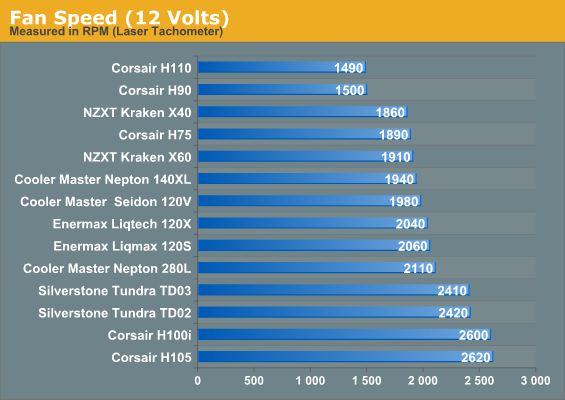
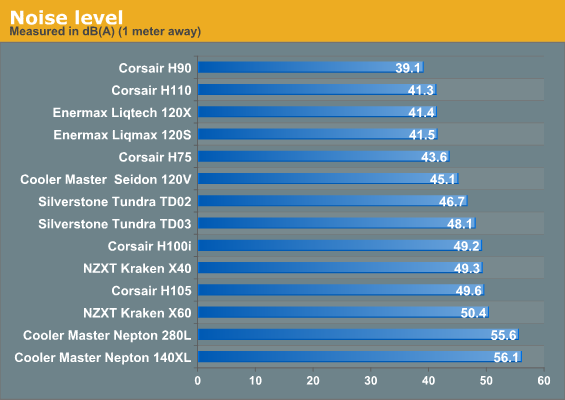
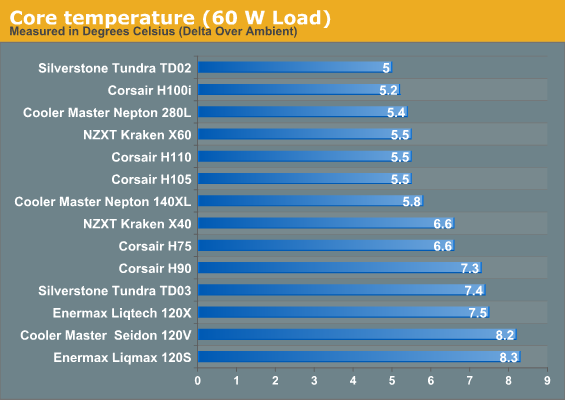
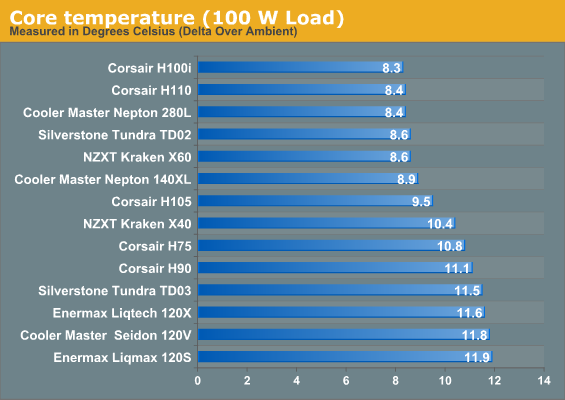
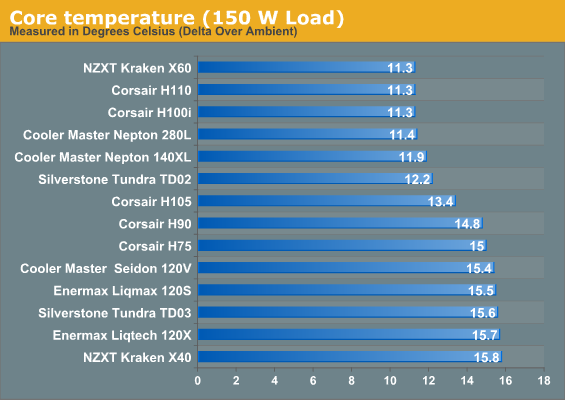
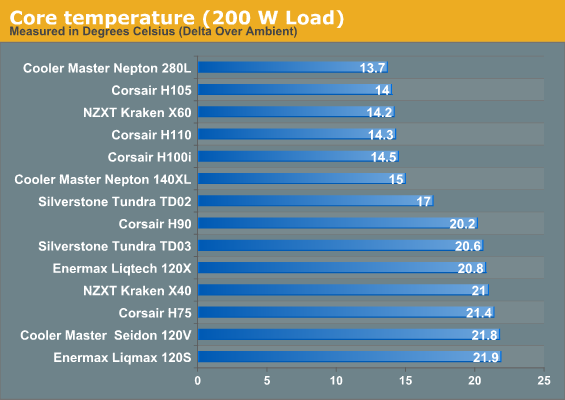

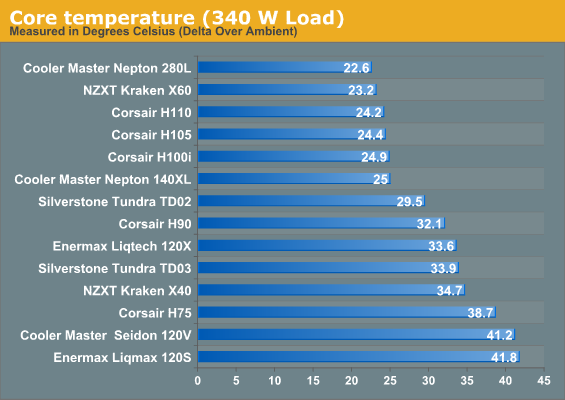

The above charts depict exactly why a user needs to be more than just a little careful when selecting a cooler. Even though they appear similar and some of them even nearly identical, the performance of each and every AIO cooler that we have tested varies greatly. For instance, Cooler Master obviously sought to provide the best heavy-load performance possible and they did manage to reach the top of our charts; however, the noise of the fans that Cooler Master supplied at maximum speed is intolerable for daily use by any standards.
To give you a rough estimate, 56 dB(A) represents about the same level of sound as a typical box fan the same distance. The Nepton 280L is closely followed by the NZXT Kraken X60 and then the Corsair H110, both of which share about the same size and design but not nearly the same noise levels. The NZXT Kraken X60 is over 5 dB(A) quieter than the Nepton 280L, a very perceptible difference, while the Corsair H110 generates only 41.3 dB(A), which is equivalent to a soft humming noise and fairly comfortable for daily use.
Naturally, the performance decreases as we move to AIO coolers with smaller radiators, with the Corsair H100i leading the coolers using 120mm fans but its stock fans run at 2600 RPM, generating high noise levels. The Enermax Liqtech 120X and Silverstone Tundra TD03 and their beefy radiators deliver great thermal performance when compared to other single-fan AIO coolers, although Enermax proved that they could offer roughly the same performance with just one fan and much lower noise levels, making Silverstone's choice to include two fans appear somewhat redundant.
Under a low thermal load however, the charts shift greatly. As the thermal load is much lower, the low temperature dissipation efficiency of the cooler now matters a lot more than its maximum thermal load capacity. Corsair's H100i offers the best thermal performance, outperforming coolers with significantly larger radiators, including Corsair's own H110, closely followed by another 240mm long cooler, the Silverstone Tundra TD02. The gap between the budget-level and high-performance products now closes, with the Corsair H75 being the most notable example, as it manages to outperform its own larger version, the H105. Apparently, bigger is not always better and the lower flow resistance of the single fan radiator gives the Corsair H75 a faster energy transfer rate at lower temperature deltas.










139 Comments
View All Comments
E.Fyll - Wednesday, February 12, 2014 - link
I do not like listing "winners", giving ratings and stuff like that. From a pure performance point of view, perhaps you are right. The H110 will not fit in a case however that can only take 280 mm long radiators. It may be too expensive for some. Too ugly for others. Too black. Even too mainstream (yes, there are people who think like that).I hate ratings because they are subjective and misleading. It reminds me exactly of that:
http://i.imgur.com/B5TgS.jpg
If I give a good rating on three products for entirely different reasons, that does not mean that they are anywhere near the same or meant for the same groups of users. Yet, most people would only check the rating and think that they are similar. Furthermore, just because I gave a product a good rating, that does not make it good for everyone; it could be entirely useless to certain people and target groups. As I said before, I am not fond of basing any part of a review on subjective elements and I despise the very idea of imposing my thoughts to others.
How about I stick to testing and writing and you (the readers) give the ratings you think each product deserves? :)
The PC Apologist - Wednesday, February 12, 2014 - link
From the AnandTech About page, under Review Philosophies:"Our reviews incorporate a mixture of objective and subjective based analysis, the balance varying where appropriate. We are not a site that exclusively relies on data based comparisons but also deliver honest user experience evaluations as well. Some reviews lend themselves to data driven analysis more than others (e.g. CPU review vs. smartphone review), but we always attempt to provide both in our coverage. I fundamentally believe that you need both to accurately portray any product. Numbers are great for comparative analysis, but without context they can be meaningless. Similarly, personal opinions are great to help explain what owning a product may be like, but without data to back up some claims the review lacks authority (e.g. average vs. good battery life begs to be quantified)."
E.Fyll - Thursday, February 13, 2014 - link
True. However, that text also describes the philosophy behind articles that belong in dozens of different categories.My objective analysis relies on testing and data. My professional opinion lies on the description of the product, its quality, flaws and uses. I can and do comment on the design and appearance. However, whether it is beautiful/useful for you or not, I believe that you can decide that for yourself, you do not need me to tell you that. :)
That being said, subjective opinions are extremely useful in other articles, but in a cooler review they are nothing sort of useless to the end reader. My personal preferences and tastes are of no use to anyone but myself. So, you can possibly say that my subjective opinion about my articles is that you can make up your own mind. ;)
Sushisamurai - Thursday, February 13, 2014 - link
Agreed. I'd buy a NZXT case vs a better case (thermal and sound performance) at a higher price, for many "irrational" reasons: my wife thinks black matches the decor of the room, and aesthetically, it may look nicer. Is it the best in terms cost and time efficiency? Hardly, but the utility I get from a happy wife is more than enough to make up for it.Sushisamurai - Thursday, February 13, 2014 - link
And... Even though some AIO coolers may perform better, sometimes the wife just wants matching logos and parts. ...so thank you Anandtech and your wonderful reviewsThe PC Apologist - Thursday, February 13, 2014 - link
I think you may be onto something there, something big.The objective vs. subjective struggle is extremely related to what I plan to offer AnandTech.
But such a challenge is no easy task, which is why I will only submit my work after much thought and deliberation.
zlandar - Wednesday, February 12, 2014 - link
Really well done and thorough roundup.killer14 - Thursday, February 13, 2014 - link
no swiftech sets.. to bad...killer14 - Thursday, February 13, 2014 - link
to bad no swiftech sets where tested, like the H220coachingjoy - Thursday, February 13, 2014 - link
Great topic, good job.Validates my usage of Corsair products.
In the minds eye H90 would work better than thinner solutions.
It does! Good for Corsair.
Thanks